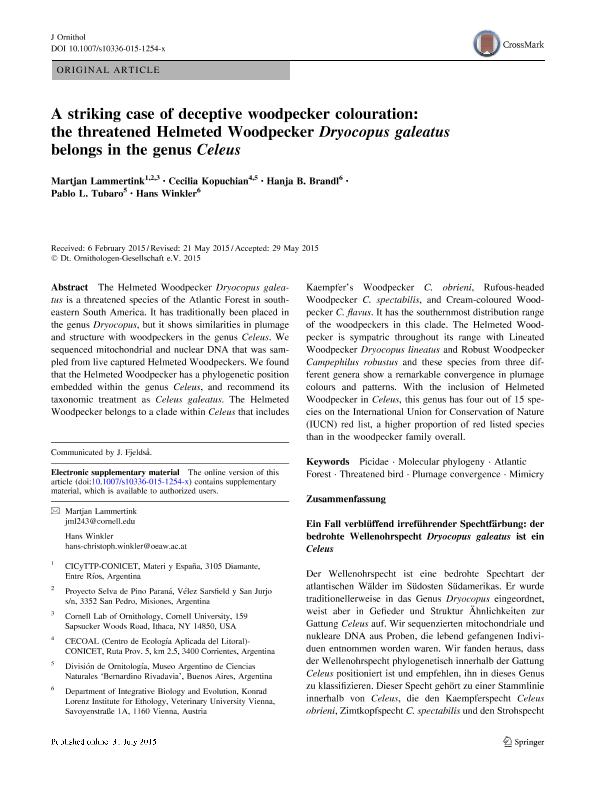Mostrar el registro sencillo del ítem
dc.contributor.author
Lammertink, J. Martjan

dc.contributor.author
Kopuchian, Cecilia

dc.contributor.author
Brandl, Hanja B.

dc.contributor.author
Tubaro, Pablo Luis

dc.contributor.author
Winkler, Hans

dc.date.available
2017-10-25T18:57:23Z
dc.date.issued
2015-07
dc.identifier.citation
Lammertink, J. Martjan; Kopuchian, Cecilia; Brandl, Hanja B.; Tubaro, Pablo Luis; Winkler, Hans; A striking case of deceptive woodpecker colouration: the threatened helmeted woodpecker dryocopus galeatus belongs in the genus celeus; Springer Heidelberg; Journal Fur Ornithologie; 157; 1; 7-2015; 109-116
dc.identifier.issn
2193-7192
dc.identifier.uri
http://hdl.handle.net/11336/27098
dc.description.abstract
The Helmeted Woodpecker Dryocopus galeatus is a threatened species of the Atlantic Forest in southeastern South America. It has traditionally been placed in the genus Dryocopus, but it shows similarities in plumage and structure with woodpeckers in the genus Celeus. We sequenced mitochondrial and nuclear DNA that was sampled from live captured Helmeted Woodpeckers. We found that the Helmeted Woodpecker has a phylogenetic position embedded within the genus Celeus, and recommend its taxonomic treatment as Celeus galeatus. The Helmeted Woodpecker belongs to a clade within Celeus that includes Kaempfer?s Woodpecker C. obrieni, Rufous-headed Woodpecker C. spectabilis, and Cream-coloured Woodpecker C. flavus. It has the southernmost distribution range of the woodpeckers in this clade. The Helmeted Woodpecker is sympatric throughout its range with LineatedWoodpecker Dryocopus lineatus and Robust Woodpecker Campephilus robustus and these species from three different genera show a remarkable convergence in plumage colours and patterns. With the inclusion of Helmeted Woodpecker in Celeus, this genus has four out of 15 species on the International Union for Conservation of Nature (IUCN) red list, a higher proportion of red listed species than in the woodpecker family overall.
dc.description.abstract
Der Wellenohrspecht ist eine bedrohte Spechtart der atlantischen Wälder im Südosten Südamerikas. Er wurde traditionellerweise in das Genus Dryocopus eingeordnet, weist aber in Gefieder und Struktur Ähnlichkeiten zur Gattung Celeus auf. Wir sequenzierten mitochondriale und nukleare DNA aus Proben, die lebend gefangenen Individuen entnommen worden waren. Wir fanden heraus, dass der Wellenohrspecht phylogenetisch innerhalb der Gattung Celeus positioniert ist und empfehlen, ihn in dieses Genus zu klassifizieren. Dieser Specht gehört zu einer Stammlinie innerhalb von Celeus, die den Kaempferspecht Celeus obrieni, Zimtkopfspecht C. spectabilis und den Strohspecht C. flavus enthält. Er stellt den südlichsten Vertreter dieser Gruppe dar. Sein Verbreitungsgebiet deckt sich mit jenen des Linienspechts Dryocopus lineatus und des Scharlachkopfspechts Campephilus robustus und diese drei Arten aus verschiedenen Genera weisen eine bemerkenswerte Konvergenz in Gefiederfärbung und -muster auf. Zusammen mit dem Wellenohrspecht beinhaltet die 15 Arten zählende Gattung Celeus vier auf der Roten Liste der IUCN stehende Arten, mehr als der Durchschnitt der Familie.
dc.format
application/pdf
dc.language.iso
eng
dc.publisher
Springer Heidelberg

dc.rights
info:eu-repo/semantics/openAccess
dc.rights.uri
https://creativecommons.org/licenses/by-nc-sa/2.5/ar/
dc.subject
Picidae
dc.subject
Molecular Phylogeny
dc.subject
Atlantic Forest
dc.subject
Threatened Bird
dc.subject
Plumage Convergence
dc.subject
Mimicry
dc.subject.classification
Bioquímica y Biología Molecular

dc.subject.classification
Ciencias Biológicas

dc.subject.classification
CIENCIAS NATURALES Y EXACTAS

dc.title
A striking case of deceptive woodpecker colouration: the threatened helmeted woodpecker dryocopus galeatus belongs in the genus celeus
dc.title
Ein Fall verblüffend irreführender Spechtfärbung: der bedrohte WellenohrspechtDryocopus galeatusist einCeleus
dc.type
info:eu-repo/semantics/article
dc.type
info:ar-repo/semantics/artículo
dc.type
info:eu-repo/semantics/publishedVersion
dc.date.updated
2017-10-04T14:51:34Z
dc.identifier.eissn
2193-7206
dc.journal.volume
157
dc.journal.number
1
dc.journal.pagination
109-116
dc.journal.pais
Alemania

dc.journal.ciudad
Berlín
dc.description.fil
Fil: Lammertink, J. Martjan. Provincia de Entre Ríos. Centro de Investigaciones Científicas y Transferencia de Tecnología a la Producción. Universidad Autónoma de Entre Ríos. Centro de Investigaciones Científicas y Transferencia de Tecnología a la Producción. Consejo Nacional de Investigaciones Científicas y Técnicas. Centro Científico Tecnológico Conicet - Santa Fe. Centro de Investigaciones Científicas y Transferencia de Tecnología a la Producción; Argentina. Proyecto Selva de Pino Paraná; Argentina
dc.description.fil
Fil: Kopuchian, Cecilia. Consejo Nacional de Investigaciones Científicas y Técnicas. Centro Científico Tecnológico Conicet - Nordeste. Centro de Ecología Aplicada del Litoral. Universidad Nacional del Nordeste. Centro de Ecología Aplicada del Litoral; Argentina. Consejo Nacional de Investigaciones Científicas y Técnicas. Oficina de Coordinación Administrativa Parque Centenario. Museo Argentino de Ciencias Naturales "Bernardino Rivadavia"; Argentina
dc.description.fil
Fil: Brandl, Hanja B.. University of Veterinary Medicine; Austria
dc.description.fil
Fil: Tubaro, Pablo Luis. Consejo Nacional de Investigaciones Científicas y Técnicas. Oficina de Coordinación Administrativa Parque Centenario. Museo Argentino de Ciencias Naturales "Bernardino Rivadavia"; Argentina
dc.description.fil
Fil: Winkler, Hans. University of Veterinary Medicine; Austria
dc.journal.title
Journal Fur Ornithologie

dc.relation.alternativeid
info:eu-repo/semantics/altIdentifier/doi/http://dx.doi.org/10.1007/s10336-015-1254-x
dc.relation.alternativeid
info:eu-repo/semantics/altIdentifier/url/https://link.springer.com/article/10.1007%2Fs10336-015-1254-x
Archivos asociados
